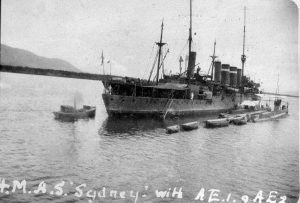- Author
- Goldrick, James, Commodore, RAN
- Subjects
- Early warships, Ship design and development
- Tags
-
- RAN Ships
- HMAS AE2
- Publication
- September 2011 edition of the Naval Historical Review (all rights reserved)
Thus, although Deakin formally announced to the Federal Parliament on 13 December 1907 a project to acquire submarines as part of a force of local defence units[7], Creswell’s concerns remained legitimate. Submarines, even as local defence assets, did not yet represent the best value for money for Australia and involved much greater risk than surface vessels. The first Australian order for warships, when it finally came in early 1909 (and after a change of government), was for destroyers only.
Phase Two: The Submarine as a High Endurance Sea Going Capability
But in the same year submarines were reaching a critical point in their development with the perfection – at least to a degree – of the ‘heavy oil’[8] or diesel engine, which was fitted in the second unit of the much enlarged and more effective D class of the Royal Navy[9] – some twice the size of its predecessors. Sir John Fisher, as ever, was quick to perceive the implications, noting in late 1908 that the type promised to be capable of ‘maintaining itself at sea, unaided for long periods’.[10] The appearance of the D class coincided with the maturing in Fisher’s mind of a new concept known as ‘Flotilla Defence’. Fisher’s brainchild was intended to utilise Britain’s technological edge over its rivals to achieve a capability jump that was both affordable and, at least temporarily, unassailable. Fisher’s scheme had two principal components, the long ranged, fast and heavily armed battle cruiser to hunt down and destroy enemy commerce raiders on the world’s oceans, and the small ‘flotilla craft’ – submarines and destroyers – to hem the enemy’s battle fleets into their own ports and, at the last ditch, protect the Empire’s bases and focal areas. Significantly, the battle cruiser and the new submarines stood out from all other warship types for their extended endurance and, in retrospect, it is clear that both were therefore well suited to the vast distances of the Pacific and Indian Oceans.
‘Flotilla Defence’ promised a solution to the much vexed question of how Australia and the other Dominions could contribute to the collective defence of the Empire and still meet their local security concerns. At the 1909 Imperial Conference, Fisher proposed that ‘Fleet Units’ centred on a battle cruiser and with supporting light craft be established at key points in the Pacific as part of a global construct. Australia was invited to acquire a fleet unit as the core of a modern Australian navy.[11] The timing was perfect; Australia had the funds available, having already promised to fund a dreadnought, and public opinion strongly supported the creation of a capability that could both ensure the protection of Australia’s own territory and local shipping and contribute to the overall defence of the Empire.
An integral component of the Fleet Unit would be submarines. The initial proposal was for three C class, but inherent to the Fleet Unit concept was that its units should be as modern as possible. The very rapid evolution of British design after the success of the diesel powered D class allowed the first build for Australia to be two of the new and even larger E class as the start of what was intended as a larger flotilla. Visionaries, such as Creswell’s assistant, Commander Hugh Thring, already envisioned how these submarines might be used to attack threatening maritime forces during the day, leaving night time attacks to the destroyers, and allowing an enemy no respite.[12]

Completed in 1914, AE-1 & AE2 arrived in Australian waters just before the outbreak of the First World War after what was, at that point, the longest voyage ever undertaken by a submarine. Significantly, and in recognition of their capability, when the time came for the Australian fleet to adopt the offensive with an amphibious attack on the German settlement at Rabaul in New Britain, the submarines were not held in Australian waters but accompanied the deployment. Although the two units did not sail independently, this was the most distant operational deployment undertaken by submarines to that time, something that has passed largely unrecognised. Their principal role came to be, in cooperation with destroyers, to provide protection for the main force at its anchorages. With the light craft on patrol outside the harbour at Rabaul, for example, then the Allied squadron could not be surprised by an enemy surface force. It was while undertaking these duties that the AE-1 tragically disappeared without trace.[13]




